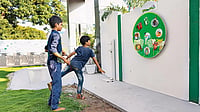As the Air India flight descended into the Chinese city of Wuhan on January 31, Captain Amitabh Singh (in picture below, first from left) could not believe the sight below him—a brilliantly lit modern metropolis, but without any signs of life. It was as if he was flying into an apocalypse. “Total silence with no radio chatter… an airport blanketed in darkness with all aircraft locked up. Not a single human or vehicle on the roads,” he recalls. For the former director operations of Air India and one of the most experienced PILots in the national carrier, it was en experience as eerie as they come.
When the government decided to evacuate all Indians stranded in the COVID-19 epicentre of Wuhan—by then under lockdown—it fell upon Singh to lead the two rescue planes that would fly into the Chinese city and bring people back. But Singh and the 68 members of the two rescue teams were informed just a day before the first flight took off. The second mission was on February 1. Singh was one of the two Air India officers who were part of both missions. As many as 324 passengers were flown back in the first mission while 323 Indians and seven Maldivian nationals were evacuated on the second flight. “We were to fly in, evacuate and fly out, keeping everyone safe.” But it was not as easy as it sounds.
In his three decades of service with AI, Singh had flown to other Chinese cities but not Wuhan. Looking back, he believes that his Wuhan flights were one of the most challenging he ever undertook considering the risk and nature of the operation. “Air India has in the past been involved in daring evacuations, be it from war-torn areas or after natural disasters. But this was the first time that we were going to the epicentre of a deadly epidemic,” Singh says. “Fortunately...we had the experience and expertise to execute the work.”
Was the crew worried about flying to a city that was the epicentre of a mysterious new viral epidemic? “No one said no (to being part of the operation),” Singh adds. “There was no fear (among the crew).”
Full protective measures were taken—full body suits, face masks and eyeglasses. Singh says they also focused on segregation—the passengers from Wuhan would be seated in the economy section, doctors and engineers in the first-class cabin, while the remaining crew would be seated in the Boeing 747’s upper deck. The crew was instructed to interact with the passengers only in case of an emergency.
When the flight landed in Wuhan, no passenger was at the airport. They were at their homes in the shuttered city. They were asked to assemble at the Indian Embassy, which was a big challenge as nothing was moving in the entire city had come to a standstill, with no public transport available. Somehow people reached the embassy. From there, they were sent to the airport on buses. Only four officers came out of the aircraft to receive the passengers from Chinese immigration officials. They were examined at the boarding gate by doctors and paramedics in the rescue team.
“In order to keep interaction with passengers to a bare minimum, the team also decided that food boxes, including water bottles, would be kept on the seats before the evacuees boarded the flight in Wuhan,” Captain Singh says.
Once the first flight landed at the Delhi airport, doctors from the health ministry received them in an isolated bay, from where they were sent to camps set up by ITBP at Manesar and Chhawla. Barring two, the team from the first mission was debriefed and sent on 14-day leave. It was time for Singh and his colleague to get ready for another flight.
ALSO READ


























